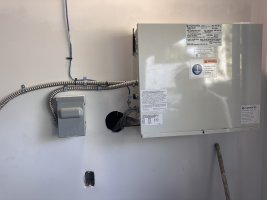-
Welcome to The Building Code Forum
Your premier resource for building code knowledge.
This forum remains free to the public thanks to the generous support of our Sawhorse Members and Corporate Sponsors. Their contributions help keep this community thriving and accessible.
Want enhanced access to expert discussions and exclusive features? Learn more about the benefits here.
Ready to upgrade? Log in and upgrade now.
You are using an out of date browser. It may not display this or other websites correctly.
You should upgrade or use an alternative browser.
You should upgrade or use an alternative browser.
Built in Garage Wall Penetration
- Thread starter jar546
- Start date
Mr. Inspector
SAWHORSE
Need to patch up hole
steveray
SAWHORSE
Nope....
No and there's another 3" diameter hole behind the disconnect.
Before you ask how I'll point out that it says, "The material filling this annular space shall not be required to meet the ASTM E136 requirements." So you give it a shot and maybe I'll approve what you did.
It would speed things along if you would convince me that the cable, wires and shroud are listed for concealment and it would help if that is backed up by the installation instructions.
The way that rubber duct is twisted tempts a 110.12 violation.
110.12 Mechanical Execution of Work. Electrical equipment shall be installed in a neat and workmanlike manner.
And ya I would go there with the empty outlet box that's missing a blank cover.
R302.5 Dwelling-garage opening and penetration protection. Openings and penetrations through the walls or ceilings separating the dwelling from the garage shall be in accordance with Sections R302.5.1 through R302.5.3.
R302.5.1 Opening protection. Openings from a private garage directly into a room used for sleeping purposes shall not be permitted. Other openings between the garage and residence shall be equipped with solid wood doors not less than 13/8 inches (35 mm) in thickness, solid or honeycomb-core steel doors not less than 13/8 inches (35 mm) thick, or 20-minute fire-rated doors, equipped with self-closing or automatic-closing and self-latching device.
Exception: Where the residence and the private garage are protected by an automatic residential fire sprinkler system in accordance with Sections R309.6 and R313, other door openings between the private garage and the residence need only be self-closing and self-latchng. This exception shall not apply to rooms used for sleeping purposes.
R302.5.3 Other penetrations. Penetrations through the separation required in Section R302.6 shall be protected as required by Section R302.11, Item 4.
R302.11(4)
At openings around vents, pipes, ducts, cables and wires at ceiling and floor level, with an approved material to resist the free passage of flame and products of combustion. The material filling this annular space shall not be required to meet the ASTM E136 requirements.
Before you ask how I'll point out that it says, "The material filling this annular space shall not be required to meet the ASTM E136 requirements." So you give it a shot and maybe I'll approve what you did.
It would speed things along if you would convince me that the cable, wires and shroud are listed for concealment and it would help if that is backed up by the installation instructions.
The way that rubber duct is twisted tempts a 110.12 violation.
110.12 Mechanical Execution of Work. Electrical equipment shall be installed in a neat and workmanlike manner.
And ya I would go there with the empty outlet box that's missing a blank cover.
R302.5 Dwelling-garage opening and penetration protection. Openings and penetrations through the walls or ceilings separating the dwelling from the garage shall be in accordance with Sections R302.5.1 through R302.5.3.
R302.5.1 Opening protection. Openings from a private garage directly into a room used for sleeping purposes shall not be permitted. Other openings between the garage and residence shall be equipped with solid wood doors not less than 13/8 inches (35 mm) in thickness, solid or honeycomb-core steel doors not less than 13/8 inches (35 mm) thick, or 20-minute fire-rated doors, equipped with self-closing or automatic-closing and self-latching device.
Exception: Where the residence and the private garage are protected by an automatic residential fire sprinkler system in accordance with Sections R309.6 and R313, other door openings between the private garage and the residence need only be self-closing and self-latchng. This exception shall not apply to rooms used for sleeping purposes.
R302.5.3 Other penetrations. Penetrations through the separation required in Section R302.6 shall be protected as required by Section R302.11, Item 4.
R302.11(4)
At openings around vents, pipes, ducts, cables and wires at ceiling and floor level, with an approved material to resist the free passage of flame and products of combustion. The material filling this annular space shall not be required to meet the ASTM E136 requirements.
Last edited:
brokenkeys
Member
Approve. Don't waste your twilight years in "God's waiting room". Get in the express line!


